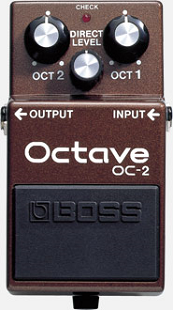Difference between revisions of "OC-2"
From Thermionic Studios
m (→General Information) |
|||
| Line 18: | Line 18: | ||
==General Information== | ==General Information== | ||
| − | This Boss pedal, is like most other octave pedals that came out in the 1980s. It is best played one note at a time, either to thicken melody runs, or on solos. | + | This Boss pedal, is like most other octave pedals that came out in the 1980s. It is best played one note at a time, and used either to thicken melody runs, or on solos. Because the OC-2 it was not created as a polyphonic pedal, if more than one note is played, the note tracking circuitry will not be able to keep up. This tends to create sounds that are more like a cacophony than multi-octave chords being played; of course, this may be the sound you're looking for. |
==Pedal Manual== | ==Pedal Manual== | ||
Revision as of 01:27, 21 June 2018
The Boss OC-2 Octave pedal uses the existing note going through it to generate 2 more notes: one octave, and two octaves down, respectively.
Subsequent Boss Octave models include:
- OC-3 Super Octave
Controls

Image from Boss' website
- Knob 1 - "Oct2": Sets the volume level for the signal two octaves lower than the dry signal.
- Knob 2 - "Direct Level": Sets the volume level for the dry signal.
- Knob 3 - "Oct1": Sets the volume level for the signal one octave lower than the dry signal.
- Footswitch 1 - "On/Off": Toggle the pedal on or off.
Bypass:Buffered
Like all Boss pedals, the OC-2 has a buffered bypass.
General Information
This Boss pedal, is like most other octave pedals that came out in the 1980s. It is best played one note at a time, and used either to thicken melody runs, or on solos. Because the OC-2 it was not created as a polyphonic pedal, if more than one note is played, the note tracking circuitry will not be able to keep up. This tends to create sounds that are more like a cacophony than multi-octave chords being played; of course, this may be the sound you're looking for.
Pedal Manual
Phase Inversion
Schematic
Artists
- Additional Sources
